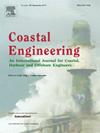Individual overtopping volumes, water layer thickness and front velocities at rubble mound breakwaters with a smooth crest in shallow water
IF 4.2
2区 工程技术
Q1 ENGINEERING, CIVIL
引用次数: 0
Abstract
Individual overtopping events are important variables when designing a coastal structure as they can deviate significantly from the mean overtopping discharge. Thus, in this study, extreme overtopping events at rubble mound structures with a smooth crest in shallow water have been studied. Both the water layer thickness (flow depth), front velocity and individual overtopping volumes are measured in a wave flume for typical coastal structures with a smooth crest in shallow water for a large range of hydraulic conditions and three different foreshore slopes. An analysis of the individual overtopping volumes shows that the largest individual overtopping volumes arise from short waves that travel on the crest of a low-frequency wave in shallow water and short waves that travel on top of the trough in deep water. Due to the temporal water level variation caused by the low-frequency waves in shallow water, there are fewer overtopping events compared to deep water conditions with the same non-dimensional overtopping discharge. However, the individual overtopping volumes of these events are larger. To quantify the extreme overtopping variables, an empirical formulation based on the relative crest height and short-wave steepness is proposed for the non-dimensional 2 % exceedance water layer thickness, front velocity and individual overtopping volume in terms of incident waves with an of 0.84, of 0.55 and of 0.85 respectively. A further small improvement is found when the low-frequency wave height and 2% exceedance wave height are included, but the added value of this expression does not outweigh the additional wave variables needed for the expression. A log-normal distribution with a constant shape and an expression for the scale of the distribution is proposed to describe the distribution of the individual overtopping volumes in shallow water which accurately captures the distribution ( of 0.90). Compared to most of the current design approach which is based on a cascade of empirical formulations, this is a significant improvement. In addition, the reasonable results for a distribution with a constant shape parameter show that the shape of the distribution does not change significantly for shallow water conditions.
浅水平滑波峰的碎石丘防波堤的个别溢水体积、水层厚度和前流速
在设计海岸构筑物时,个别的过顶事件是重要的变量,因为它们可能显著偏离平均过顶流量。因此,在本研究中,研究了浅水中具有光滑波峰的碎石丘结构的极端漫顶事件。在波浪水槽中测量了水层厚度(水流深度)、前缘速度和单个过顶体积,并对典型的浅水平滑波峰结构进行了测量,并对三种不同的前岸坡度进行了分析。对单个过顶量的分析表明,最大的单个过顶量来自浅水低频波波峰上传播的短波和深水波谷顶部传播的短波。在相同的无量纲过顶流量条件下,由于浅水低频波引起的水位随时间的变化,与深水条件相比,浅水的过顶事件较少。然而,这些事件的个别超额量更大。为了量化极端过顶变量,提出了基于相对波峰高度和短波陡度的无因次2%超限水层厚度、锋面速度和单个过顶体积以入射波表示的经验公式,R2分别为0.84、0.55和0.85。当包括低频波高和超出2%波高时,发现进一步的小改进,但该表达式的附加价值并不超过表达式所需的额外波变量。提出了一个形状恒定的对数正态分布及其尺度表达式来描述浅水中单个过顶体积的分布,准确地捕捉了分布(R2为0.90)。与目前大多数基于经验公式级联的设计方法相比,这是一个重大的改进。此外,对于形状参数恒定的分布,合理的结果表明,浅水条件下分布的形状变化不明显。
本文章由计算机程序翻译,如有差异,请以英文原文为准。
求助全文
约1分钟内获得全文
求助全文
来源期刊

Coastal Engineering
工程技术-工程:大洋
CiteScore
9.20
自引率
13.60%
发文量
0
审稿时长
3.5 months
期刊介绍:
Coastal Engineering is an international medium for coastal engineers and scientists. Combining practical applications with modern technological and scientific approaches, such as mathematical and numerical modelling, laboratory and field observations and experiments, it publishes fundamental studies as well as case studies on the following aspects of coastal, harbour and offshore engineering: waves, currents and sediment transport; coastal, estuarine and offshore morphology; technical and functional design of coastal and harbour structures; morphological and environmental impact of coastal, harbour and offshore structures.
 求助内容:
求助内容: 应助结果提醒方式:
应助结果提醒方式:


